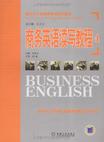商务英语读写教程4
出版时间:2009-5 出版社:机械工业出版社 作者:孙友义 页数:370
内容概要
伴随着经济全球化和我国经济国际化的进程,国内外大中型企业、跨国公司等对既懂商务又会英语的复合型人才的需求与日俱增,这也促进了我国高等教育商务英语专业的快速发展。目前,全国有700多所高等院校开设了外贸英语、商务英语等课程,工商管理、金融等商科专业也都开设了以商务为核心内容的英语课程,部分院校甚至设立了商务英语专业。近几年来,全国性的商务英语教学、学术研讨会频频召开。我国国际商务的快速发展、人才市场对商务英语人才的强劲需求以及外语就业市场人才多元化推动了英语专业的教学改革和教材建设,各院校都迫切需要一套能体现商务特色与人才培养规格相适应的新教材,以改变英语教材与人才培养和需求不相适应的状况。 商务英语属于专门用途英语,国外大学多将其归为ESP(English for specialPurposes)。目前,我们国内这样系统的专业教材并不是很多。王正元教授领衔总主编、由全国20余所大学40余名英语教授、副教授、讲师历时两年多编写的这套“新时代大学商务英语系列教材”是我国高等教育商务英语教材建设的一个新成果。 这套教材共14本,包括读写、视听说、写作、口译,涵盖了商务英语的基本主体课程。编者基于“商务知识+英语能力=核心竞争力”的编写理念,力求在企业战略、市场营销、人力资源、企业文化、经营运作等商务语境中培养学生的英语交际能力。商务知识与英语能力相结合、商务语境与语言活动相结合、能力培养与就业需求相结合的编写思路使这套教材商务内容丰富,英语操练有的放矢,凸显了人才培养规格,给这套教材带来了亮点。
书籍目录
序前言Unit 1 The World Trade Organization 》Objectives 》Listening 》Reading 》Vocabulary Drills 》Grammar Focus 》Speaking Skills 》Translation Drills 》Writing Drills Unit 2 Doha Trade Talks 》Objectives 》Listening 》Reading 》Vocabulary Drills 》Grammar Focus 》Speal6ng Skills 》Translation Drills 》Writing DrillsUnit 3 Why“Fair”Trade Is a Bad Deal for Poorest Farmers 》Objectives 》Listening 》Reading 》Vocabulary Drills 》Grammar Focus 》Speaking Skills 》Translation Drills 》Writing DrillsUnit 4 Internation Trade Negotiation 》Objectives 》Listening 》Reading 》Vocabulary Drills 》Grammar Focus 》Speaking Skills 》Translation Drills 》Writing DrillsUnit 5 Dumping&Anti-dumping 》Objectives 》Listening 》Reading 》Vocabulary Drills 》Grammar Focus 》Speaking Skills 》Translation Drills 》Writing DrillsUnit 6 Debate on Auti-dumping 》Objectives 》Listening 》Reading 》Vocabulary Drills 》Grammar Focus 》Speaking Skills 》Translation Drills 》Writing DrillsUnit 7 Import and Export 》Objectives 》Listening 》Reading 》Vocabulary Drills 》Grammar Focus 》Speaking Skills 》Translation Drills 》Writing DrillsUnit 8 Business NegotiationUnit 9 Internation Trade and Logistics:A Million-Job Economic StrategyUnit 10 Implications of China and the WTO for the Logistics IndustryUnit 11 UPS:Logistical Management of Distribution NetworksUnit 12 Why FedEx Is Gaining Ground?Unit 13 UPS&FedEx Compete to DeliverUnit 14 The eBay School of BusinessUnit 15 Filling Pantries Without a MiddlemanUnit 16 The Economy:Why so Gloomy?Appendix 1 Transcripts for ListeningAppendix 2 Answer Keys for ListeningAppendix 3 Answer Keys for ListeningAppendix 4 Answer Keys Grammar FocuaAppendix 5 Reference Version for Translation DrillsAppendix 6 Reference Version for Writing Assignment Appendix 7 VocabularyAppendix 8 Notes
章节摘录
The bilateral nature of VERs contributes to a series of subsequent effects. Since a VER can raise the price of the product in the importing country, thereis an incentive created to circumvent the restriction.In the case of theJapanese auto VERs, the circumvention took a variety of forms. Since thequantity of auto trade between Japan and the US was limited but the value oftrade was not, Japanese automakers began upgrading the quality of theirexports to raise their profitability. By the late 1980s, new higher-quality autolines such as Acura, Infiniti, and Lexus made their debut. Alternatively, ( Japanese autos assembled in the US were not counted as part of the exportrestriction-only complete autos exported from Japan were restricted. ) Thus,after the VERs were implemented, Honda, Mazda, Toyota, Mitsubishi, andNissan all opened assembly plants in the US. A quicker circumvention was accomplished by shipping knockdown sets (unassembled autos) to Taiwan and South Korea, where they were assembled and exported to the US market. Textile VERs Another interesting effect of VERs occurred in the textile industry beginning in the 1950s. In the mid 50s, US cotton textile producers faced increases in Japanese exports of cotton textiles which negatively affected theirprofitability. The US government subsequently negotiated a VER on cotton textiles with Japan. Afterwards, textiles began to flood the US market from other sources like Taiwan and South Korea. The US governrnent responded by. negotiating VERs on cotton textiles with those countries. By the early 1960s, other textile producers in the US, who were producing clothing using the new synthetic fibers like polyester, began to experience the same problem with Japanese exports that cotton producers faced a few years earlier. So VERs were negotiated on exports of synthetic fibers from Japan to the US. During this period European textile producers were facing the same pressures as US producers and the EEC negotiated similar VERs on exports from many southeast Asian nations into the EEC.
图书封面
评论、评分、阅读与下载
